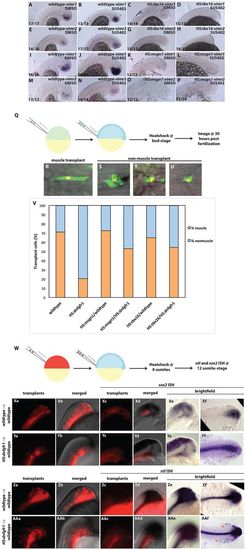
FGF promotes mesoderm induction and inhibition of the NMP state via tbx16 and msgn1. (A-P) Expression of vimr1 and vimr2 was analyzed in SU5402- or DMSO-treated HS:tbx16, HS:msgn1 and wild-type sibling control embryos. Embryos were heat shocked at the 12-somite stage and analyzed at the 20-somite stage. Activation of tbx16 eliminates vimr1 and vimr2 expression in DMSO-treated (C,G) and SU5402-treated (compare D,H with B,F) embryos. Similarly, msgn1 activation inhibits vimr1/2 expression in DMSO-treated (K,O) and SU5402-treated (compare L,P with J,N) embryos. (Q-V) A transplant assay was used in epistasis experiments to determine whether tbx16 and msgn1 function downstream of FGF during termination and if these genes could rescue somite fate of FGF-inhibited tailbud cells. Wild-type donor embryos were injected with a mixture of fluorescein-dextran and heat shock-inducible HS:tbx16, HS:msgn1 or control HS:NLS-kikume plasmids. At sphere stage, the cells from these donor embryos were transplanted into the ventral margin of unlabeled wild-type shield stage host embryos, which targets them to the NMP population (Q). Embryos were heat shocked at the bud stage and examined at 30 hpf. The kikume protein was photoconverted prior to imaging and the lineage analysis was performed based on cell shapes and location of the transplanted cells. The majority of the transplanted wild-type cells contribute to somites, as do cells with tbx16 and msgn1 overexpression (R,V). The majority of the transplanted HS:dnfgfr1 cells are excluded from somites and do not form muscle (S-V) and remain in the tail region. However, upon the presence of tbx16 or msgn1, FGF-inhibited cells contribute to somites and form skeletal muscle (V). (W-AAf) A similar assay was used to determine whether transplanted cells that lack FGF function cell-autonomously maintain NMP markers sox2 and ntla (W). Host embryos containing transplanted wild-type cells and stained for sox2 (Xa-f) or ntla (Za-f) exhibit normal sox2 and ntla expression patterns, whereas host embryos with HS:dnfgfr1 cells have ectopic sox2 (Ya-f) and ntla (AAa-f) expressing cells in the tailbud (red arrowheads). Xa-e,Ya-e,Za-e,AAa-e, lateral views, anterior bottom; Xf,Yf,Zf,AAf, dorsal views, anterior left.
|

